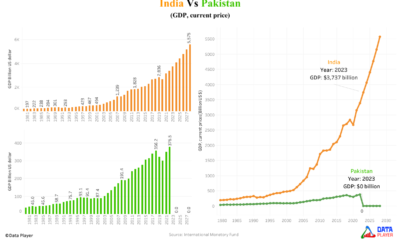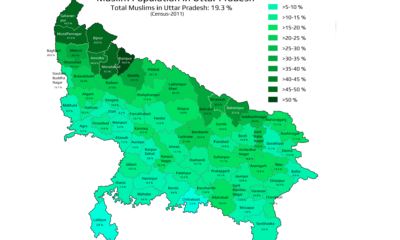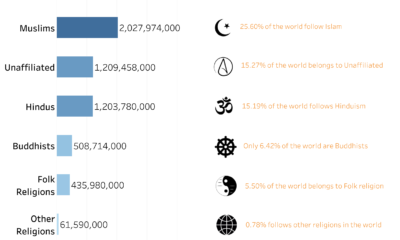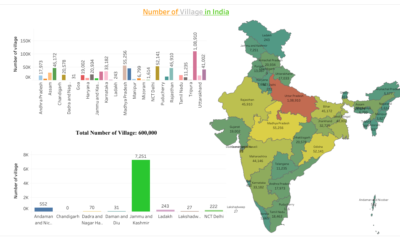Published
5 months agoon
Excerpt: India’s trade footprint in the global market continues to evolve rapidly, driven by its strategic exports in energy, electronics, and IT services, while mineral fuels and high-tech goods dominate its import landscape. A deep dive into 2023 trade data reveals how India is positioning itself as both a critical manufacturing hub and a growing consumer economy.
India’s Global Trade in 2023: Goods and Services at a Glance
India’s engagement with global trade spans a diverse portfolio, from oil exports to digital services. In 2023, the country’s total merchandise exports reached $431.4 billion, while imports stood significantly higher at $672.1 billion, reflecting India’s expanding consumption base. On the services front, India’s dominance in the global IT sector remained evident, with total service exports worth $309.4 billion against imports of $176.8 billion.Top Commodities Exported by India
India’s top ten exported goods reflect a blend of natural resources, high-value industrial products, and pharmaceuticals. Leading the list are:- Mineral fuels and oils – $89.3 billion (20.7%)
- Precious stones and metals – $33.4 billion (7.7%)
- Electrical machinery – $32.3 billion (7.5%)
- Machinery and mechanical appliances – $29.3 billion (6.8%)
- Pharmaceutical products – $21.3 billion (4.9%)
Top Goods Exported by India in 2023
India’s Major Imports: A Strong Energy Dependency
India’s reliance on global energy markets is evident, with mineral fuels and oils topping its imports at a staggering $220.6 billion, accounting for nearly one-third of total merchandise imports.Other notable import categories include:- Electrical machinery – $76.1 billion
- Precious stones and metals – $72.7 billion
- Machinery and mechanical appliances – $57.1 billion
- Organic chemicals – $27.3 billion
Top Goods Imported by India in 2023
India’s Services Export Strength: Powered by IT and Business Services
In 2022, India exported over $309 billion worth of services, spearheaded by the booming IT and business services sectors. The country’s global leadership in software and back-office operations is underscored by:- Telecommunications, computer, and information services – $144.8 billion (46.8%)
- Other business services – $74.9 billion (24.2%)
- Transport and travel services – combined $58.9 billion (19%)
India’s Imported Services: Business and Logistics Take the Lead
Service imports into India, totaling $176.8 billion in 2022, were largely centered around professional services, global transport logistics, and tourism[2].Key imported services include:- Other business services – $57.3 billion (32.4%)
- Transport – $43.5 billion (24.6%)
- Travel – $25.9 billion (14.6%)
Top Services Imported by India in 2022
Trade Trends and Strategic Insights
India’s trade data reveal several underlying economic dynamics:- Energy security remains a critical concern, with high dependence on imported fossil fuels.
- Export strength is shifting from traditional commodities to high-value services, particularly IT and pharmaceuticals.
- India’s role in the global electronics and machinery supply chain is growing on both export and import fronts.
- Inward tourism and logistics spending reflect India’s increasing global integration and rising middle-class consumption.
Conclusion: The Road Ahead for India’s Trade
India’s evolving trade profile highlights a maturing economy—one that is leveraging its digital strengths while tackling structural import dependencies, especially in energy. As India positions itself for greater self-reliance and global leadership, strategic trade policy and investment in key sectors like renewable energy, technology, and services will be vital.References
- UN Comtrade. (2024). Available at: https://comtrade.un.org [Accessed 25 Jul. 2025].
- ITC Trade Map. (2024). Available at: https://www.trademap.org [Accessed 22 Jul. 2025].
Economy
Trump’s 2025 Tariffs on India Explained: Full List, Dates, Products, and 50% Duty Impact
Published
5 months agoon
August 7, 2025Excerpt: Trump’s 2025 tariff campaign marked a sharp turn in U.S.-India trade, with duties on Indian goods doubling in just four months.
In 2025, during his second presidency, Donald Trump imposed sweeping tariffs on India in a series of aggressive moves that escalated U.S.-India trade tensions to historic levels. Citing concerns over India’s trade practices and its continued purchases of Russian oil, the Trump administration rolled out three major tariff actions between April and August—raising import duties on Indian goods up to 50%. These tariffs hit critical sectors including textiles, electronics, jewellery, and auto parts, causing ripple effects in both countries’ economies.
Trump’s Tariff Actions on India (2025)
The first salvo came on April 2, 2025, when Trump launched a 27% “reciprocal tariff” on several Indian imports as part of a global “Liberation Day” trade policy [3]. This was followed by a 25% tariff announced on July 30, directly targeting India’s refusal to curb Russian energy imports [4].
The final escalation occurred on August 6, adding another 25% on top of the previous rate, effectively bringing tariffs on most Indian goods to 50% [5].
Sectors Most Affected by the Tariffs
The tariff waves were not evenly felt. While pharmaceuticals remained largely exempt due to their essential role in U.S. healthcare, almost every other major export category from India faced steep duties. These additional costs directly impacted U.S. importers, consumers, and Indian manufacturers alike.
Key Indian Export Categories Affected (2025)
Retailers warned that prices for consumer goods like smartphones, clothing, and jewellery could surge in U.S. markets, with some sectors like gems and jewellery seeing a +24% increase in retail price [6].
Geopolitical Dimensions
Trump’s rationale was not purely economic. The tariffs were directly linked to India’s ongoing energy and defense trade with Russia, which the U.S. viewed as a threat to NATO-aligned global security efforts. By economically pressuring India, the administration hoped to force a pivot in its foreign policy [7].
India, on the other hand, labeled the moves as “unfair, unjustified, and politically motivated,” threatening retaliation at the WTO and in its own trade policies [8].
A Historic Low in US-India Trade Relations
By August 2025, U.S.-India trade relations had reached a historic low. The 50% tariff wall on Indian exports created significant market disruptions and frayed one of the world’s most strategic partnerships. While pharmaceuticals were spared, consumer goods and industrial sectors were not, and the long-term consequences for global trade remain uncertain.
References
- UN Comtrade. (2024). Available at: https://comtrade.un.org [Accessed 25 Jul. 2025].
- ITC Trade Map. (2024). Available at: https://www.trademap.org [Accessed 22 Jul. 2025].
- Wikipedia. Tariffs in the Second Trump Administration. Available at: https://en.wikipedia.org/wiki/Tariffs_in_the_second_Trump_administration
- Times of India. India-US trade deal: Trump announces 25% tariff on India. Available at: https://timesofindia.indiatimes.com/business/india-business/india-us-trade-deal-trump-announces-25-tariff-on-india-plus-penalty-for-buying-energy-and-arms-from-russia/articleshow/122998698.cms
- Reuters. Trump imposes extra 25% tariff on Indian goods. Available at: https://www.reuters.com/world/india/trump-imposes-extra-25-tariff-indian-goods-ties-hit-new-low-2025-08-06/
- IndiaTimes. Donald Trump’s India tariffs set to hit US shoppers hard. Available at: https://indiatimes.com/trending/donald-trumps-india-tariffs-set-to-hit-us-shoppers-hard-phones-auto-parts-jeans-jewellery-to-get-costlier-665564.html
- Al Jazeera. Trump imposes 25 percent tariff on Indian goods over Russian oil. Available at: https://www.aljazeera.com/news/2025/8/6/trump-imposes-25-percent-tariff-on-indian-goods-over-russian-oil
- Economic Times. India reacts to 50% US tariffs. Available at: https://economictimes.indiatimes.com/news/economy/foreign-trade/trump-tariff-from-50-on-india-and-brazil-to-35-on-canada-heres-how-nations-stack-up-in-comparison/articleshow/123145315.cms
Economy
Is India Really a ‘Dead Economy’? A Deep Dive Into the Facts Trump Didn’t Mention
When Donald Trump recently called India a “dead economy,” it sparked global headlines and trended across social media. For many, this bold remark raised questions — is there any truth to it? Is India really falling behind, or is something else happening beneath the surface?
Published
5 months agoon
August 2, 2025When Donald Trump recently called India a “dead economy,” it sparked global headlines and trended across social media. For many, this bold remark raised questions — is there any truth to it? Is India really falling behind, or is something else happening beneath the surface?
While the term “dead economy” might make for great clickbait, India’s recent economic data tells a very different story — one of resilience, expansion, and global leadership. From strong GDP growth to booming exports and a youth-driven workforce, India is proving itself far from stagnant.
Contrary to claims of economic stagnation, India’s economy is not just alive — it is accelerating. Despite global challenges like inflation, interest rate volatility, and geopolitical friction, India continues to outperform most major economies. Backed by strong fundamentals, a young population, and targeted policy reforms, India stands poised for long-term growth.
One of the clearest indicators of India’s economic health is its consistently high GDP growth rate. According to the International Monetary Fund (IMF), India is expected to grow at 6.5% in FY 2024–25, maintaining its position as the world’s fastest-growing large economy[9].
Table 1: India’s Real GDP Growth (Fiscal Years)
Alongside growth, India’s manufacturing strength is expanding rapidly, largely due to the Production-Linked Incentive (PLI) scheme. This initiative has boosted domestic production and exports, particularly in electronics and pharmaceuticals.
Export Growth by Sector (FY 2024–25)
Another key strength is India’s demographic profile. With a median age of just 28.2, India has one of the youngest populations in the world. In comparison, China’s median age is around 39.8, and Japan’s is nearly 50[10] [11].
Table 3: Median Age by Country (2023)
In addition, India’s digital and fintech sectors are booming. With over 800 million internet users and a record number of digital transactions via UPI, India is quickly becoming a global digital leader.
Conclusion: A “Dead Economy”? Only If You Ignore the Data
India may have its challenges, but calling it a “dead economy” is not just misleading — it’s uninformed. The real story is of a country surging ahead, backed by numbers, people, and momentum. Trump may have made headlines, but India is making history.
References
- UN Comtrade. (2024). Available at: https://comtrade.un.org [Accessed 25 Jul. 2025].
- ITC Trade Map. (2024). Available at: https://www.trademap.org [Accessed 22 Jul. 2025].
- Wikipedia. Tariffs in the Second Trump Administration. Available at: https://en.wikipedia.org/wiki/Tariffs_in_the_second_Trump_administration
- Times of India. India-US trade deal: Trump announces 25% tariff on India. Available at: https://timesofindia.indiatimes.com/business/india-business/india-us-trade-deal-trump-announces-25-tariff-on-india-plus-penalty-for-buying-energy-and-arms-from-russia/articleshow/122998698.cms
- Reuters. Trump imposes extra 25% tariff on Indian goods. Available at: https://www.reuters.com/world/india/trump-imposes-extra-25-tariff-indian-goods-ties-hit-new-low-2025-08-06/
- IndiaTimes. Donald Trump’s India tariffs set to hit US shoppers hard. Available at: https://indiatimes.com/trending/donald-trumps-india-tariffs-set-to-hit-us-shoppers-hard-phones-auto-parts-jeans-jewellery-to-get-costlier-665564.html
- Al Jazeera. Trump imposes 25 percent tariff on Indian goods over Russian oil. Available at: https://www.aljazeera.com/news/2025/8/6/trump-imposes-25-percent-tariff-on-indian-goods-over-russian-oil
- Economic Times. India reacts to 50% US tariffs. Available at: https://economictimes.indiatimes.com/news/economy/foreign-trade/trump-tariff-from-50-on-india-and-brazil-to-35-on-canada-heres-how-nations-stack-up-in-comparison/articleshow/123145315.cms
- Khandekar, N. (2025). India to remain fastest growing major eco with 6.5% growth in FY26: IMF. [online] The Economic Times. Available at: https://economictimes.indiatimes.com/news/economy/indicators/india-to-remain-fastest-growing-major-eco-with-6-5-growth-in-fy26-imf/articleshow/118649360.cms.
- World Bank (2023). Population, Total. [online] The World Bank. Available at: https://data.worldbank.org/indicator/SP.POP.TOTL.
- CIA (2024). Median age – The World Factbook. [online] www.cia.gov. Available at: https://www.cia.gov/the-world-factbook/field/median-age/country-comparison/.
Economy
UK–India Trade Hits £42.6 Billion: Export Surge and Investment Trends in 2024
Published
5 months agoon
July 27, 2025Excerpt: The United Kingdom’s trade relationship with India has gained momentum, reaching £42.6 billion over the latest four quarters to Q4 2024. This article unpacks the latest figures on exports, imports, market share, foreign direct investment, and India’s broader economic trajectory, offering context on what these numbers mean for businesses and policymakers.
UK–India Trade Overview
In the four quarters ending Q4 2024, total UK–India trade stood at £42.6 billion, marking an 8.3% uptick (£3.3 billion) compared to the same period a year earlier [12]
- Overall trade ranking: 11th among the UK’s global partners.
- Exports: £17.1 billion (+5.8% or £945 million), ranking 12th in export destinations.
- Imports: £25.5 billion (+10.1% or £2.3 billion), ranking 11th among import sources.
Goods vs Services: Export and Import Composition
India has become a vital market for both UK goods and services. Over the latest year:
- Goods exports: £7.0 billion (41.1% of total goods exports), up 15.4% (£938 million).
- Services exports: £10.1 billion (58.9% of total services exports), up marginally by 0.07% (£7 million).
- Goods imports: £10.8 billion (42.3% of total goods imports), up 3.0% (£314 million).
- Services imports: £14.7 billion (57.7% of total services imports), up 15.9% (£2.0 billion).
UK Market Share in India
The UK has expanded its footprint in India’s trade landscape in 2023, with market share rising across all categories [13]
UK Market Share in Indian Trade (2023)
Foreign Direct Investment Flows
Investment ties reflect a two-way flow:
- UK outward FDI stock in India: £17.4 billion at end‑2023, down 13.1% (£2.6 billion) from 2022.
- UK inward FDI stock from India: £13.1 billion at end‑2023, up 28.5% (£2.9 billion).
This divergence underscores evolving investment strategies, with UK firms recalibrating their allocation even as Indian investors increase their UK presence [14]
India’s Economic Outlook
India’s robust growth trajectory is pivotal for future UK–India trade dynamics. The latest projections for India’s GDP show sustained expansion:
India GDP Growth and Per Capita Projections
India’s global GDP rank is moving up, from 5th place in 2023–2024 to an anticipated 4th by 2025, reflecting the country’s increasing economic heft [15]
Implications for UK Businesses
- Diversify supply chains to capitalize on growing services demand in India.
- Monitor FDI trends to leverage inbound and outbound investment opportunities.
- Align with India’s growth sectors—notably technology and consumer services—to sustain export momentum.
Complete data sets underpinning these analyses are available from the respective statistical agencies.
References
- UN Comtrade. (2024). Available at: https://comtrade.un.org [Accessed 25 Jul. 2025].
- ITC Trade Map. (2024). Available at: https://www.trademap.org [Accessed 22 Jul. 2025].
- Wikipedia. Tariffs in the Second Trump Administration. Available at: https://en.wikipedia.org/wiki/Tariffs_in_the_second_Trump_administration
- Times of India. India-US trade deal: Trump announces 25% tariff on India. Available at: https://timesofindia.indiatimes.com/business/india-business/india-us-trade-deal-trump-announces-25-tariff-on-india-plus-penalty-for-buying-energy-and-arms-from-russia/articleshow/122998698.cms
- Reuters. Trump imposes extra 25% tariff on Indian goods. Available at: https://www.reuters.com/world/india/trump-imposes-extra-25-tariff-indian-goods-ties-hit-new-low-2025-08-06/
- IndiaTimes. Donald Trump’s India tariffs set to hit US shoppers hard. Available at: https://indiatimes.com/trending/donald-trumps-india-tariffs-set-to-hit-us-shoppers-hard-phones-auto-parts-jeans-jewellery-to-get-costlier-665564.html
- Al Jazeera. Trump imposes 25 percent tariff on Indian goods over Russian oil. Available at: https://www.aljazeera.com/news/2025/8/6/trump-imposes-25-percent-tariff-on-indian-goods-over-russian-oil
- Economic Times. India reacts to 50% US tariffs. Available at: https://economictimes.indiatimes.com/news/economy/foreign-trade/trump-tariff-from-50-on-india-and-brazil-to-35-on-canada-heres-how-nations-stack-up-in-comparison/articleshow/123145315.cms
- Khandekar, N. (2025). India to remain fastest growing major eco with 6.5% growth in FY26: IMF. [online] The Economic Times. Available at: https://economictimes.indiatimes.com/news/economy/indicators/india-to-remain-fastest-growing-major-eco-with-6-5-growth-in-fy26-imf/articleshow/118649360.cms.
- World Bank (2023). Population, Total. [online] The World Bank. Available at: https://data.worldbank.org/indicator/SP.POP.TOTL.
- CIA (2024). Median age – The World Factbook. [online] www.cia.gov. Available at: https://www.cia.gov/the-world-factbook/field/median-age/country-comparison/.
- ONS.gov.uk. (2025). UK Trade with India: Quarterly Statistics. Available at: https://www.ons.gov.uk/tradewithindia [Accessed 24 Jul. 2025].
- Department for International Trade. (2025). UK Market Share in India 2023. Available at: https://www.gov.uk/dit/marketshareindia [Accessed 25 Jul. 2025].
- UNCTAD. (2025). World Investment Report 2024. Available at: https://unctad.org/wir2024 [Accessed 24 Jul. 2025].
- IMF.org. (2025). World Economic Outlook. Available at: https://www.imf.org/weo-april2025 [Accessed 26 Jul. 2025].

Muslim Population in Goa (2025 Update): District-Wise Data, Percentage & Analysis

Muslim Population in Telangana (2025 Update): District-Wise Data, Percentage & Analysis

Muslim Population in Karnataka (2025 Update): District-Wise Data, Percentage & Analysis

Trump’s 2025 Tariffs on India Explained: Full List, Dates, Products, and 50% Duty Impact

Muslim Population in Odisha (2025 Update): District-Wise Data, Percentage & Analysis

Muslim Population in Goa (2025 Update): District-Wise Data, Percentage & Analysis

Muslim Population in Telangana (2025 Update): District-Wise Data, Percentage & Analysis

Muslim Population in Karnataka (2025 Update): District-Wise Data, Percentage & Analysis
Trending

 Technology2 years ago
Technology2 years agoHighest number of software developers by country in the world 2023 by GitHub | Data Player

 Economy3 years ago
Economy3 years agoWhy Pakistan’s economy is drowning while India’s economy is touching the sky

 Religion1 year ago
Religion1 year agoMapped: What are the muslims population in Uttar Pradesh | State of India

 Demographics1 year ago
Demographics1 year agoMapped: Average Working Hours by European Countries in 2024

 Religion2 years ago
Religion2 years agoWorld’s Largest Religion in 2024 | Data Player

 Religion1 year ago
Religion1 year agoMapped: What is Muslim Population in West Bengal by District wise 2011

 Demographics2 years ago
Demographics2 years agoWhat are the Number of Villages in India by its State and Union Territory

 Demographics3 years ago
Demographics3 years agoMassive population size by Indian states 2023

















UhoIxSsCmpUFeEfnzqfwiT
November 14, 2025 at 11:37 pm
tmQNpsaZMqbHWOCkr